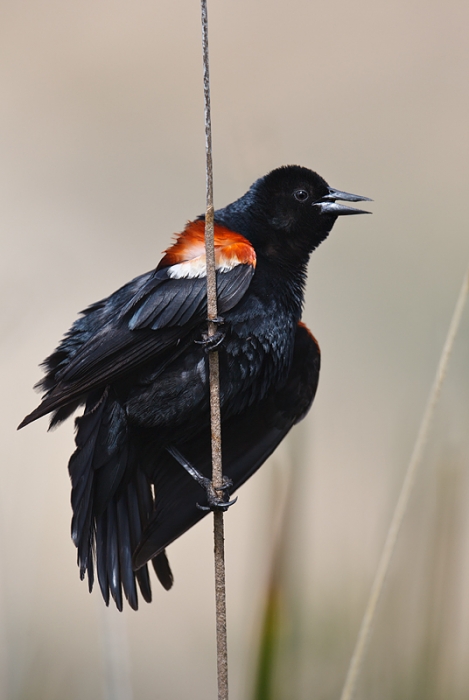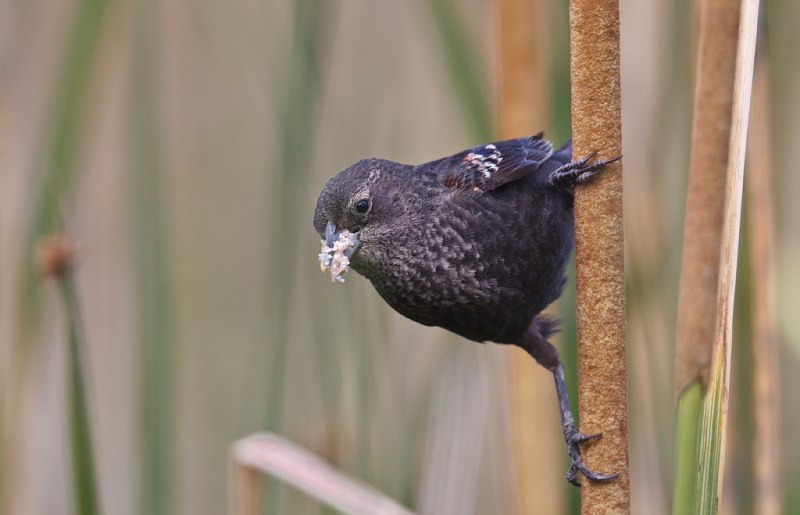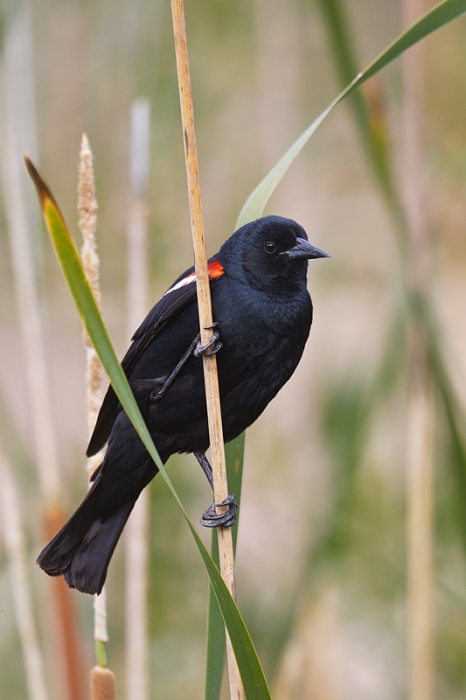|
This male Tricolored Blackbird was photographed with the tripod-mounted Canon 800mm f/5.L IS lens and the Canon EOS-1D Mark IV. ISO 400. Evaluative metering at +1 stop: 1/1250 sec. at f/6.3 in Manual mode. Central sensor (by necessity) AI Servo/Rear Focus AF on the bird’s face and re-compose (during a rare lull in the wind). Click here if you missed the Rear Focus Tutorial. Click on the image for a larger version. |
Frozen and Battered Again in California: Trikes!
On the Morro Bay IPT we ran into a stretch of unexpectedly cold and windy weather. No IPT this time as I am currently on a busman’s holiday in San Diego with Denise Ippolito but Friday and Saturday past were again unexpectedly cold and incredibly windy. On Saturday we traveled with friend and multiple IPT veteran Mike Goldhamer of San Diego to a Tricolored Blackbird colony in Jacumba, California. As we drove over the summits of the Laguna and the Cuyamaca Mountains on I-8 it was windy, foggy, and raining. As we exited the car at Jacumba it was a very cold and ridiculously unseasonable 39 degrees. It was sunny. And the wind was a steady 25 mph from the southwest with gusts to forty….
It Was A Very Tough Morning
As regular readers know wind against sun conditions make bird photography very difficult at best. Without proper clothing and gloves the cold made things even more difficult. The birds as always were landing on reeds and cattails that were blowing like crazy. This made trying to focus accurately nearly impossible. We were working on a downhill slope so it was difficult to position your tripod while maintaining the height that you needed. And finally, the substrate was uneven, rocky in one spot, muddy in another, and covered with a thick layer of dried reeds and cattails just inches from either. This made getting a secure base from which to work a big problem. As I said, it was a very tough morning. Jeez, I almost forget that as the morning wore on the sun was coming in and out so that getting the right exposure was challenging at best. Yikes!
None-the-less, we perservered. For the most part this meant waiting for a bird to land on a relatively clean perch that was not blocked by other reeds and cattails and then waiting for the wind to abate just a bit. By 10:30am, once again frozen and battered, we all had had enough so we packed up and headed back to San Diego. Surprisingly, each of us had created a few decent images.
|
This female Tricolored Blackbird was photographed with the tripod-mounted Canon 800mm f/5.L IS lens, the 1.4X III TC, and the Canon EOS-1D Mark IV. ISO 800. Evaluative metering at +1 1/3 stops: 1/400 sec. at f/9 in Manual mode. Central sensor (by necessity) AI Servo/Rear Focus AF on the bird’s breast active at the moment of exposure. Click here if you missed the Rear Focus Tutorial. Click on the image for a larger version. |
Female tricoloreds (trikes for short) are much plainer than female Red-winged Blackbirds. The bird in the image above was bringing a mouthful of food to the young in the nest but we could not figure out what the food was.
|
This male Tricolored Blackbird was photographed with the tripod-mounted Canon 800mm f/5.L IS lens, the 1.4X III TC, and the Canon EOS-1D Mark IV. ISO 500. Evaluative metering at +1 1/3 stops: 1/320 sec. at f/9 in Manual mode. Two sensors up from the central sensor (by necessity) AI Servo/Rear Focus AF on the bird’s neck active at the moment of exposure. Click here if you missed the Rear Focus Tutorial. Click on the image for a larger version. |
Male tricoloreds are very similar to male red-wings but have whitish rather than yellow wing-bars. It is always exciting for me to photograph a new species no matter how difficult the conditions.
Take a Moment
Take a moment to let us know which is your favorite image and why.
Canon 500 & 600mm f/4 L IS II Lenses Shipping Soon!
The long-awaited Canon 500mm f/4L IS II lens and the equally long-awaited Canon 600mm f/4L IS II lens should be shipping within a week as they are en route to dealers now. I can help you get one soon at the lowest price. Here’s how.
Pre-order the new Series II 500mm lens by clicking on this link: Canon EF 500mm f/4L IS II USM. Or pre-order the new Series II 600mm lens by using this link: Canon EF 600mm f/4L IS II USM. When you receive your B&H receipt via e-mail forward it to me by e-mail here. I will e-mail it to my affiliate contact at B&H to help expedite your order. Do understand that the demand for these lenses will be huge. If by chance you are able to secure your lens from another source (likely at a higher price) you can simply cancel your B&H pre-order; your credit card is not charged until and unless the lens is shipped. It is a win-win situation for all who wish to get their hands on one or both of these lenses. By using the links above you will be thanking BIRDS AS ART for all the free information that we provide in Bulletins, on the blog, and by answering your e-mail questions (as I have been doing for close to two decades now). So thanks! In addition, you can save your receipt(s) and cash them in for multiple contest entries in the BIRDS AS ART 2nd International Bird Photography Competition.
You can check the amazing lighter weights and specs of the new lenses as compared to the old lenses here. Aside from being well lighter each of the new lenses is well sharper than the previous versions and features 4-stop Image Stabilization. You can learn more about the two new lenses here and here.
Important Note
Though B&H is now accepting pre-orders, you will not–due to their holiday closing–be able to pre-order your lens (or to order anything else) until Monday, May 28th at 9:45PM EDT. So set your alarm for 9:46pm on this coming Monday evening if you wish to be the first on your block to get you hands on either of these two Series II lenses.
Shopper’s Guide.
Support both the Bulletins and the Blog by making all your B & H purchases here.
Below is a list of the gear talked about in this blog post. Thanks a stack to all who have used the Shopper’s Guide links to purchase their gear as a thank you for all the free information that we bring you on the Blog and in the Bulletins. Before you purchase anything be sure to check out the advice in our Shopper’s Guide.
Canon 800mm f/5.6L IS lens. Right now this is my all time favorite super-telephoto lens.
Canon EF 1.4X III TC. This new TC is designed to work best with the new Series II super-telephoto lenses.
Canon EOS-1D Mark IV professional digital camera body. The very best professional digital camera body that I have ever used.
And from the BAA On-line Store:
LensCoats. I have a LensCoat on each of my big lenses to protect them from nicks and thus increase their re-sales value. All my big lens LensCoat stuff is in Hardwood Snow pattern.
LegCoat Tripod Leg Covers. I have four tripods active and each has a Hardwood Snow LegCoat on it to help prevent further damage to my tender shoulders 🙂 And you will love them in mega-cold weather….
GT3532 LS. This one replaces the GT3530LS Tripod and will last you a lifetime. I’ll be commenting on this new model soon. In short, I like it.
Mongoose M3.6 Tripod Head. Right now this is the best tripod head around for use with lenses that weigh less than 9 pounds. For heavier lenses, check out the Wimberley V2 head.
CR-80 Replacement Foot for Canon 800. When using the 800 on a Mongoose as I do, replacing the lens foot with this accessory lets the lens sit like a dog whether pointed up or down and prevents wind-blown spinning of your lens on breezy days by centering the lens directly over the tripod.
Double Bubble Level. You will find one in my camera’s hot shoe whenever I am not using flash.
The Lens Align Mark II. I use the Lens Align Mark II pretty much religiously to micro-adjust all of my gear an average of once a month and always before a major trip. Enjoy our free comprehensive tutorial here.
BreezeBrowser. I do not see how any digital photographer can exist without this program.

















Crud … busted again for not reading the whole thing (sorry!). The first is far and away my favorite. Great job with a tough exposure and composition is, of course, great. It really shows the struggle the bird might be going through just to perch, while beautifully showing off the bird’s behaviour and best attributes. BG is killin’ … those verticals REALLY complement that big strong vertical in front.
Thanks G. They were really blowin’ in the wind. FYI, Gloria is the author of two great e-books on composition: Natural Design and Composition Maps. If you struggle to design pleasing images it would behoove you to get a copy of each of these great guides.
Love that bird 🙂 NICE Arthur!!
Arthur, I love the first shot for the wing positions, but all are beautiful photos. Sorry to hear about the cold….it was +32 degrees Celsius here on Monday, but with the humidity it felt more like 40.
Thanks Andrew. We are headed for Trinidad on Monday-84 degrees every day….
The third. Better detail and for me a better composition. Number one would be my second choice. Predominately black birds are very hard to photograph.
Detail is very hard to get. I think the Solution for this is to have sufficient light.
How far away are you (in feet) are you for most of your shots. This kind of info on all shots would be very informative for me. I am struggling to judge at what distance with each lense it is impossible to get a clear image. I think one of my problems with unclear shots is too much enlarging, not enough lens.
Is this info in your literature? I can not find such.
Cheers from big fan.
I was roughly between 25 and 32 feet for these images. Big lenses are very nice especially the expensive ones. I far prefer soft light for photographing glossy black birds….
My favorite is the first image of the calling blackbird. I love how they puff their feathers up big for an impressive show and then deflate, only to do it over and over again. I hope the girls are looking! I also like the creamy bkgd with the subtle lines of vegetation. All three are beautiful exposures, of course.
Many tanks :). Lady D says’ “Hi.”
My favorite. Probably the third image. I’ve unsuccessfully tried to get a similar shot of a red winged blackbird in that position for years. I prefer it over the vocalizing trike in the first image simply because the bird looks neater without the feathers ruffled out. A totally illogical reason.
In general from what I saw on only the one day, they do not sing and display as demostratively as Red-winged Blackbirds normally do. But that might have been because we were relatively late in the breeding cycle….
I’ll check that out the next time I drive through there. Thanks
I understand that you need to watch out for the meth labs…. Or have they been eradicated?
Third image is my favourite, simple classic composition with nice detail in the feathers and good head angle. Like the twisting reed blade too.
Thanks. And the soft light too :).
Great pictures of the blackbirds. How in the heck did you end up in Jacumba “Acumba”????? Where you by the spinach and baby lettuce fields that our company sells the seed for or over by the nudist colony????? Just wondering?
We were by a tiny lake. Heading west make a right on Jacumba Street. The pond will be on your left near the end of the block.
Nice job on the blackbirds. They can be challenging to expose properly even in the best of conditions. Sounds like a good time 🙂
Thanks. And as you can see, we had changing light. #1 in the sun. 2 & 3 with a bit of cloud cover. Note the vastly different exposures and the different ISOs for the two males.